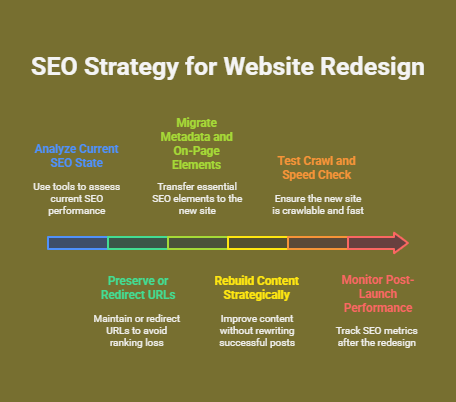
4 Jul 2025
How to Redesign Your Website Without Killing Your SEO
Good website design isn’t simply how beautiful a site looks; it’s about function, form, and performance. But whether you’re starting from scratch or just tweaking your online presence a little, , it’s all too easy to neglect what’s even more important: your SEO equity.
If you have an existing site that ranks well for valuable search engine keywords, gets consistent organic traffic, and has built up some backlinks over time, you are sitting on SEO capital that’s too valuable to risk. And like any asset, it requires protection, particularly during a website redesign carried out with SEO in mind.
This article explores how to retain and even enhance the value of your SEO when you give your website a fresh coat of paint.
Why Redesigns Can Affect Rankings
In the pursuit of improvement, the functional aspects of a website can often be sidelined. Sometimes, developers modify the URL without any redirection strategy. Designers can often overlook structured content. SEO basics, such as meta descriptions, alt tags, and internal linking, get lost in the shuffle. Search engines notice these gaps instantly. This is followed by a plummet in ranking, search visibility, and traffic.
Avoiding that outcome doesn’t require extraordinary effort; it just needs a process.

Step 1: Audit: Take a Look at What Works Already
Before you start designing colors, fonts, and UX flows, prioritize the data. Use resources like Google Search Console, Ahrefs, or SEMrush to discover:
- Your highest-ranking pages
- Keywords driving the most traffic
- Backlinks pointing to specific URLs
- Pages with high dwell time and high engagement
This is an assessment of your current SEO state, a map of everything that’s already working. Treat it as sacred.
Step 2: Preserve or Redirect URLs Carefully
One of the worst things that can happen during a redesign is changing URLs without properly redirecting them with 301 redirects. The problem is that when URLs change, and you don’t redirect, you break the connection. The search engine rankings will eventually continue to point to the old content or not at all.
Whenever possible, preserve your top URLs. If modifications are required, forward these permanently to the new version. This helps search engines understand that the content has moved, but it’s still credible.
Step 3: Migrate Metadata and On-Page Elements
Titles, meta descriptions, H1 tags, image alt text—these things aren’t just on-page SEO fluff; they’re signals. And they tend to disappear when websites are redesigned.
Before launch, verify that the developers have captured all the mandatory technical SEO elements of the old website and replicated them for the new site. If your CMS supports it, export metadata and re-upload it once the redesign goes live.
Step 4: Rebuild Content Strategically
You shouldn’t rewrite a post that is doing well for the sake of “freshness.” Instead, I would focus on improving clarity, adding internal linking and make your content closely align with current keyword research. Rewrite only what needs to be improved — never what is already ranking.
Step 5: Try a Test Crawl and Speed Check
When your staging site is set, perform a technical SEO audit. Can Google crawl it effectively? Are there broken links or redundant pages? Is it responsive and mobile friendly?
Leverage tools such as Screaming Frog to simulate how search engine bots will perceive your new site. Address problems that come up before they go live, not after the rankings plunge!
Step 6: Watch after launch very closely.
Expect some fluctuation for a short period of time, but record everything from day 1. Set up tracking for:
- Keyword positions
- Page speed
- Bounce rates
- Crawl errors
Look at Google Search Console on a daily basis for the first week, and then every week for the next 30 days. If SEO rankings start to plummet, be responsive. And in this business, a slight wrong turn leads to a lot of wasted money.
The Right Way to Redesign
A website redesign isn’t meant to reset your progress — it’s supposed to compound it. If done carefully, a redesign can enhance UX and conversion rates and help maintain your presence in search engine results pages (SERPs). The important part is not allowing creativity cover one’s technical SEO strategy.
At Biztal box, we focus on redesigns that are search engine–friendly and take design and discovery to the next level. We don’t just create aesthetic websites—we’re a future-proof digital partner.
Are you planning a redesign? Let’s ensure that your SEO not only survives — but thrives.
Also Read:- What Is Ad Fatigue?
Leave a Reply
Your email address will not be published. Required fields are marked *












Comments